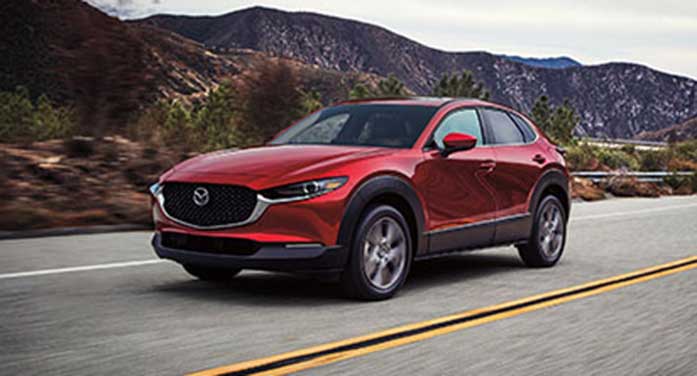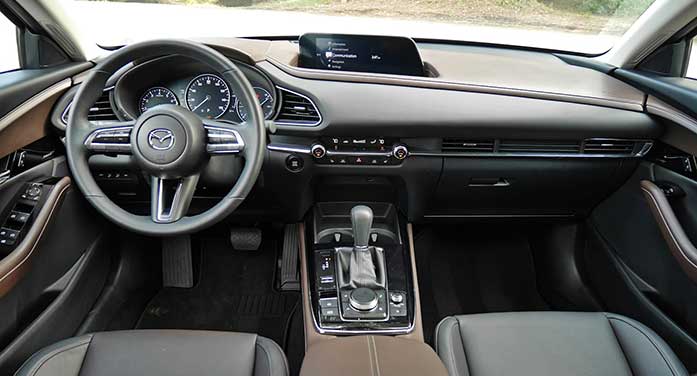
In terms of design, purpose and overall flavour, this subcompact SUV is very much like the Mazda CX-5. Similar wheelbase, drivetrain, and driving experience, and it is aimed at roughly the same group of buyers
 Car manufacturers sometimes market their products in a confusing way.
Car manufacturers sometimes market their products in a confusing way.
In the old days, it was called “badge engineering,” where one model would be gussied up or slightly altered and sold as something else – even though it was virtually identical to the vehicle it was based on. The Oldsmobile Cutlass, for example, was sold in over 20 variations: people liked it, so General Motors capitalized on that and offered it in as many iterations as they could.
I’m not saying that’s the case with the Mazda CX-30, but in terms of design, purpose and overall flavour, this subcompact SUV is very much like the Mazda CX-5. It has a similar wheelbase and drivetrain, a similar driving experience and is aimed at roughly the same group of buyers.
It’s slightly cheaper (depending on the model), a little smaller in terms of interior elbow room and offers roughly the same fuel economy. This is how the company describes it: “The versatile design of the 2022 Mazda CX-30 offers ease and agility without compromising on capability and space.” That description could apply to the CX-5 or just about every other subcompact SUV on the market. Just think of the CX-30 as CX-5 lite.
| RELATED CONTENT | |
| Mazda CX-30 Turbo has plenty of punch By Ted Laturnus |
|
| Tuning out the Mazda CX-5 because of a stubborn radio By Ted Laturnus |
|
| Driver-friendly Mazda CX-5 is easy to get along with By Ted Laturnus |
|
|
Available in three trim levels, plus an all-electric model, the CX-30 is powered by either a normally aspirated 2.0-litre four-cylinder or a turbocharged 2.5-litre engine. The former engine comes with the base GX, while the turbo version is standard with the GS and GT. All come with all-wheel drive and a six-speed automatic transmission.
I drove the GT version, which has all the bells and whistles, including steering-wheel paddle shifters, larger 18-inch wheels and tires, navigation system, leather upholstery, heated steering wheel, and heads-up display – or, as Mazda likes to call it, “windshield projected Active Driving Display.” I really grew to appreciate this latter feature since it seems more intuitive than the usual dash-mounted readout.
Rear cargo space is 1,280 litres with the second-row seats folded flat. This is less than the CX-5, which will give you 1,680 litres. The Toyota RAV4 offers 1,976 litres, while a Honda HR-V provides 1,559.
The driving experience is very Mazda-esque. The radio controls are still counter-intuitive and unnecessarily complicated. But noise, vibration and harshness (NVH) are exceptionally good, which tells me the car is well screwed together. Most of the basic things – ergonomics, seat comfort, rear cargo access – are state of the art. Mazda has mastered the art of building innocuous, mainstream practical family transport, and the CX-30 is in the thick of things in this highly-populated market.
One minor thing: I found the heat, ventilation, and air conditioning (HVAC) inefficient. In warm weather, the air conditioning, for example, seems to struggle; the flow-through vents are too small, as far as I’m concerned. I found myself constantly fiddling with the ventilation settings, which became annoying.

I drove the GT version, which has all the bells and whistles, including steering-wheel paddle shifters, navigation system, leather upholstery, heated steering wheel and heads-up display
Mazda, for the most part, builds good automobiles. But they seem to get it wrong when it comes to switchgear and interior modern conveniences. Things are more complicated than they need to be and, after driving just about everything in the company’s lineup, I think this area of their products needs a rethink.
On the other hand, the CX-30 has a nice sense of balance and feels connected to the road. This is one of those things that’s hard to nail down – the car is either right in terms of poise and feel, or it isn’t. The CX-30 feels right to me.
I still don’t understand the marketing pitch, though. The CX-3, which the CX-30 replaces, was just fine, thank you very much. And the CX-5, even though it’s slightly larger and about $3,000 pricier, also fills this niche admirably.
Maybe it’s a case of change for its own sake.
2022 Mazda CX-30
Base price: $34,750
Engine: turbocharged 2.5-litre four-cylinder
Transmission: six-speed automatic
Drive: all-wheel
Horsepower: 186 at 6,000 rpm
Torque: 186 foot pounds at 4,000 rpm
Fuel economy (litres/100 km): 10.5 city and 7.9 highway, with premium or regular gas
Some alternatives: Honda HR-V, Mazda CX-5, Kia Sportage, Hyundai Kona, Subaru Crosstrek, Nissan Qashqai, Toyota C-HR, Nissan Kicks, Volkswagen Tiguan, Kia Seltos
Ted Laturnus has been an automotive journalist since 1976. He was named Canadian Automobile Journalist of the Year twice and is past president of the Automobile Journalists Association of Canada (AJAC). For interview requests, click here.
The opinions expressed by our columnists and contributors are theirs alone and do not inherently or expressly reflect the views of our publication.
© Troy Media
Troy Media is an editorial content provider to media outlets and its own hosted community news outlets across Canada.



“Radio controls are still counter-intuitive and unnecessarily complicated” Wow!
Took me two minutes to master. Perhaps you shouldn’t be driving heavy complicated equipment?
Would you prefer the smudgy touchscreens you have to reach for?
The vast majority of professional reviewers think the switchgear is fantastic with a class-leading interior. Your review sir is in a minority, and hence has little validity.
“Radio controls are still counter-intuitive and unnecessarily complicated” Wow!
Took me two minutes to master. Perhaps you shouldn’t be driving heavy complicated equipment?
Would you prefer the smudgy touchscreens you have to reach for?
The vast majority of professional reviewers think the switchgear is fantastic with a class-leading interior. Your review sir is in a minority, and hence has little validity.